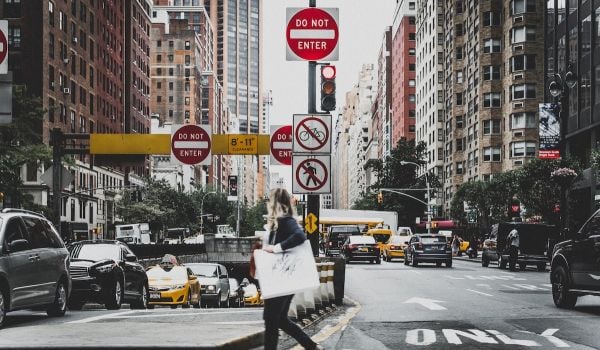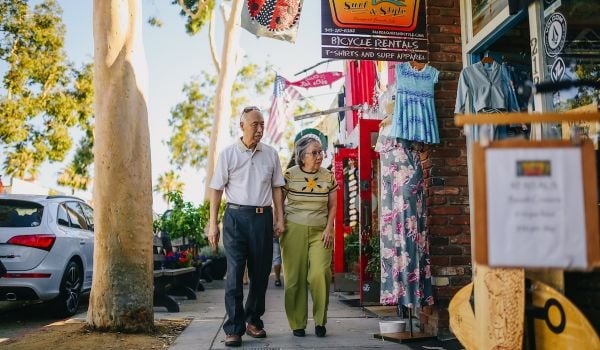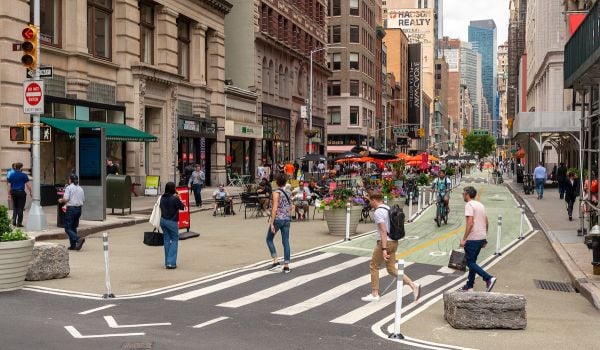On my way to work the other day, I happened to get off of one bus just in time to catch another one across the street. So I jogged my way across the street and was on my way to a timely departure when a gloved cop finger beckoned me. “Come here” it said. The officer told me that, even though I was in the crosswalk and the light was not red, my street crossing was unsafe and thus warranted a citation.
Here in L.A. we have crosswalk signs that count down the seconds until the yellow light turns on. 10, 9, 8, etc. When I took my first step into the crosswalk that morning, the sign was on 2, meaning I had 2 seconds before the light was to turn yellow, and another 4 or 5 until the relentless flood of L.A. commuters from the intersecting street would rush in my direction. Being fairly young and spry, I made it across the street before the light turned red. I was safe. But apparently, I was not safe enough for one officer of the LAPD.
He does have a point, though. I could have been more safe by just waiting for the next light. Some enraged commuter could have ran a red and took me out with no problem. So, yes, I admit I must thank this officer for looking out for my safety. But, I have to think that maybe it would be a more effective strategy to target the source of auto-pedestrian accidents rather than the victim.
Admittedly some pedestrians make really dumb decisions sometimes and probably deserve to get hit in certain circumstances. But the majority or them are just trying to get across the street to catch a bus or walk their dog. The bad pedestrians are far outnumbered by the bad drivers.
The officer told me his sting was part of a task force on preventing pedestrian-auto collisions and that 21 pedestrians were hit and killed by drivers in L.A. in the past year, a not insignificant number. In the entire state of California last year, 888 pedestrians, pedalcyclists and other non-motorists were killed in auto accidents, according to the National Highway Traffic Safety Administration. That amounts to 21 percent of the total 4,236 traffic-related fatalities in the state. Nationally, 5,740 were killed in 2006, or 13 percent of the 42,642 fatalities. These are pretty big numbers and proof that there is a problem.
But for some perspective, compare those numbers to the fatality rates for drivers and passengers: there were 3,348 fatalities for car and truck drivers and passengers in California in 2006, and 36,902 in the country. That’s nearly a 4:1 ratio of motorist deaths to pedestrian deaths in the state, and a more-than 6:1 ratio at the national level.
We call know statistics can be misinterpreted and taken out of context, but it’s pretty easy to see that people are much more likely to die driving in a car than walking in the street.
It’s hard to say how the LAPD’s enforcement is distributed in terms of officers to pedestrians versus officers to motorists, but it seems like more attention should be paid to those behind the wheels of what are essentially deadly weapons. The way our cities are built is enough of a disincentive to walking, and punishing people for merely being possible victims of bad drivers is a backwards approach that makes walking even less appealing.
These policing efforts should be more focused on the cars and bad drivers that make streets unsafe for pedestrians. Attack the source of the problem. A few well-deserved drivers license suspensions will do far more to improve our cities’ pedestrian environments than a jaywalking ticket ever will. I’ll pay for my offense, but that $100 is not going to take us any closer to solving the deadly problem posed by irresponsible drivers. More enforcement of drivers will mean more license suspensions will mean more feet on the street. That’s safety in numbers.
Read more from Nate at The Interchange, Planetizen’s daily blog.










